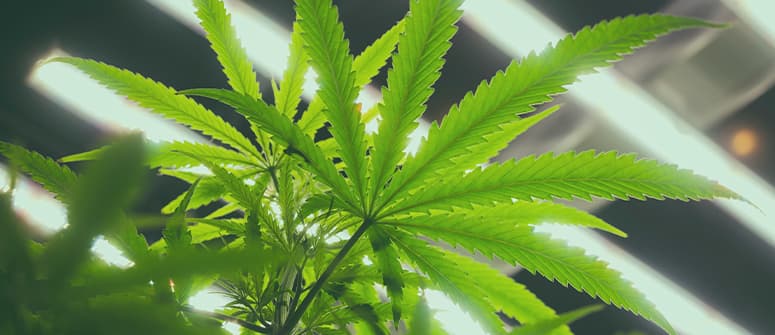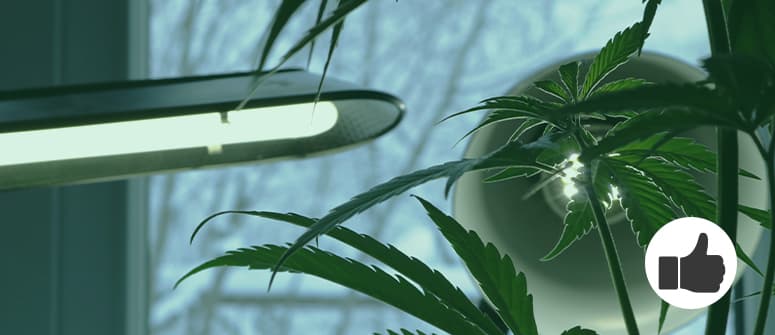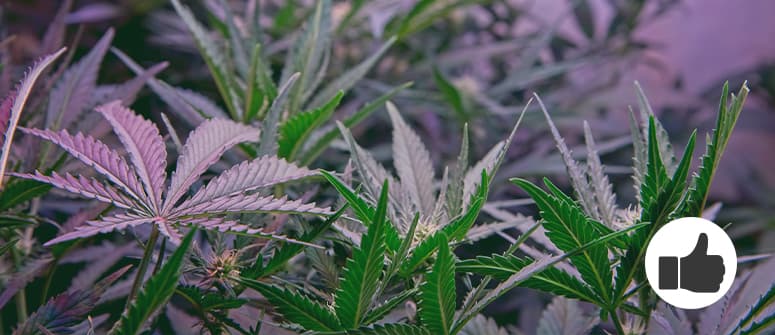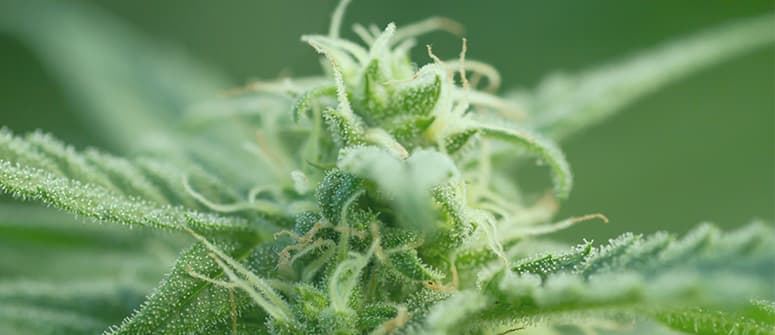What is the best light cycle for autoflowering cannabis plants?

Autoflowering cannabis strains offer a lot of flexibility in terms of light schedule. Not as picky as their photoperiod cousins, we can afford to play around a little in an attempt to maximise production and quality. But which light schedule is best for autoflowering cannabis? Find out here.
Contents:
Cannabis cultivation requires a finessed approach. At least, it did until autoflowering cannabis seeds became so good that they are now a fully viable alternative to their photoperiod counterparts. This type of cannabis is not dependent on the light schedule to move through its life cycle, offering a huge advantage in terms of flexibility for cannabis growers.
But what light schedules should you use to grow autoflowering cannabis plants? Find out all about it below.
How does light affect autoflowering cannabis plants?

Unlike photoperiod cannabis plants, autoflowering specimens don’t require a change in the light cycle (or photoperiod) to trigger different phases of their growth. For instance, a photoperiod cannabis plant will remain in the vegetative stage—where it focuses on growing upward and outward, without producing flowers—if it receives 18 hours of light and 6 hours of darkness per day. This is known as an 18/6 schedule. To make it produce flowers, growers switch to a 12/12 light cycle, to mirror the naturally declining light levels at the end of summer, when cannabis plants produce flowers in an attempt to reproduce before the winter.
Autoflowering cannabis, on the other hand, doesn’t need these signals. Why not? Because autoflowers contain ruderalis genetics. Ruderalis is a subspecies of cannabis endemic to Siberia and Central Asia. Given the long, cold, dark winters, and the long days of summer, ruderalis has developed an “internal clock” that dictates when it enters different stages of its life cycle.
Ruderalis begins flowering after a genetically predetermined amount of time, regardless of light schedule. Among modern autoflowering strains, this period is usually around 3–4 weeks. Naturally, these strains of cannabis tend to be short (50–60cm) and bulky, with few branches, 3-fingered leaves, and low yields of airy bud. However, with careful crossing, backcrossing, and stabilisation techniques, it’s possible to cross photoperiod plants with autoflowers to retain the best of each strain.
So, given that light doesn’t trigger flowering in autos, how should you set up your lights when growing autoflowering cannabis indoors?
Autoflowering cannabis light cycles: indoors

Growers of photoperiod strains tend to utilise specific light cycles during specific periods of development; for example, 18/6 during growth and 12/12 during bloom. With autoflowering strains, though, there is a lot more room for experimentation. As there is no mandatory schedule to follow, different growers have different opinions about how much light autos will benefit from during each stage.
12/12 light cycle
A 12/12 light cycle is standard for flowering photoperiod cannabis plants, so many growers like to stick to it when growing autos.
That being said, cannabis uses light for photosynthesis, which gives it the energy to grow. And the more light it gets, the more energy it has, and the more potential it has to grow and yield abundantly. So many feel that limiting the light cycle to 12/12 for autoflowers in bloom is a wasted opportunity, as you could potentially double the amount of light they receive compared to this.
Even if you opt for a 12/12 cycle during the flowering stage, an 18/6 cycle will likely be better during the vegetative stage. Though you can technically veg autos at 12/12, the final results might not be as impressive as those of an 18/6 cycle.
Pros:
- Tried and tested cycle for the flowering stage
- Mimics natural light levels during late summer and autumn
- Lower electricity costs
- Keeps grow spaces cooler
- Allows you to grow flowering autos alongside photoperiod strains
Cons:
- Wasted opportunity to grow larger plants
- Smaller yields
18/6 light cycle
An 18/6 schedule is probably the most commonly used for autoflowering plants during both veg and bloom. Photoperiod strains respond favourably to this schedule during the vegetative stage, and with autoflowers, the same is true.
Though it doesn’t exactly mimic the light schedule outdoors, this cycle delivers great results, with plants that produce ample yields of well-developed buds. As far as can be seen, there do not seem to be any negative effects associated with this light cycle during the vegetative or flowering stage. As a result, autos can be exposed to 18/6 from germination all the way up to harvest, making your job even easier.
Pros:
- Plenty of light, meaning plenty of energy
- Large yields
- Moderate lighting cost
- Can veg autos and photoperiod strains in the same grow space
Cons:
- Grow space could get hot, so potentially not suitable in hot climates
20/4 light cycle
With this light schedule, we’re really starting to mimic northern summers, when the sun barely sets.
Subjecting plants to a 20/4 schedule from the get-go is very possible with autoflowering cannabis, and seems to yield good results. In fact, it’s pretty difficult to make a judgement between 18/6 and 20/4. 20/4 is likely less commonly used, but that may be because it’s not a schedule used for photoperiod plants—and it’s more expensive—whereas 18/6 is known to almost all weed growers anyway.
Pros:
- Large yields
- Vigorous growth
Cons:
- Unclear if it’s any better than 18/6
- Greater energy output and expenses
- More heat generated
24h light cycle
Perhaps surprisingly, autoflowers can thrive without a moment’s sleep in their entire lives. Some growers swear by keeping the lights on for a cannabis plant’s whole life. But does it work?
While it seems apparent that plants can handle this, it’s unclear whether this technique has any benefit. Many cannabis cultivators point out that even autos can benefit from rest. Proponents of 24/0, on the other hand, claim that their plants do just fine without it.
So far, it’s unknown who—if anyone—is right in this debate.
Pros:
- Some claim it produces huge amounts of bud
- Maximises the amount of light your plant receives
Cons:
- Uses a large amount of energy, perhaps unnecessarily
- Autoflowers may benefit from a dark period each day
- Can generate a lot of heat, depending on the lighting setup
Do autoflowers need darkness?
As you might have ascertained, the answer is: nobody knows!
In general, plants seem to enjoy a daily period of darkness, even a short one. Photoperiod cannabis plants absolutely require darkness—and proper darkness—to effectively move through their life cycle. Even a small amount of light at the wrong time can throw photoperiod plants off.
With autoflowers, though, this is not the case. They definitely can exist on almost any light schedule, as long as they have enough light to survive. Whether they benefit from some darkness, though, remains unclear.
Which autoflowering light cycle is best?

So, what's the best light schedule for autoflowers? Once again, the answer is: nobody knows!
With this one, however, we can speculate a little. On the whole, most growers seem to agree that an 18/6 light cycle strikes a good balance between efficacy and energy use. It exploits autoflowering cannabis’ ability to receive more than 12 hours of light per day during the flowering phase, without upping energy use, and energy costs, associated with a 20/4 or 24/0 cycle.
While it remains unclear whether these longer light cycles are more beneficial, a fair share of weed growers opt to save some money and energy. However, if you fancy trying a longer cycle, rest assured that it shouldn't hurt your autos—indeed, it could help them.
What is the best light spectrum for autoflowering cannabis?

The light schedule is not the only thing that matters when growing cannabis. Light spectrum plays a major role too. The human eye can only detect a tiny fraction of the whole light spectrum, though we can feel other parts as heat (infrared), and witness other parts in the form of burnt skin (ultraviolet).
Plants utilise a larger spectrum of light than the eye can detect, utilising colder blue light at one end and warmer red light at the other. But it’s not as simple as putting your autos under one bright light covering this whole spectrum.
Vegetation vs flowering stage
Much as plants take signals from the length of daylight to determine what they should be doing, the available spectrum gives them signals too.
In the spring, the way the sun shines through the Earth’s atmosphere results in an abundance of blue light, with less red. In the summer, there is a lot of bright white light, and the spectrum is at its most diverse. Come autumn, when the days are waning, red light dominates, and blue is on the decline.
Moving with these changes, the cannabis plant has adapted to correspond to this cycle. Blue light promotes vigorous root growth and stem growth, strong white light is best for vegetation and overall growth, and red light promotes abundant flower and trichome production.
Though a general white light will suffice for all stages of an autoflowering plant’s growth, catering to its specific needs at certain stages of its life cycle will likely optimise its growth and yield potential.
Autoflowering cannabis light cycle: outdoors

Growing autoflowers outdoors can be highly rewarding. Due to their shorter life cycle and less rigorous light requirements, it’s possible to achieve multiple harvests throughout the summer season. Plant in April or May in the Northern Hemisphere, and it’s quite possible to achieve a first harvest in June or July. And then, you can plant another crop and harvest again before autumn truly sets in.
Nevertheless, don’t expect each crop to be equally impressive or abundant. The same principles apply as with indoor growing; plants growing during June and July are probably going to be the biggest and best, as they’ll get the most light, whereas those growing toward the end of summer might be a bit smaller.
Regardless of whether you grow indoors or outdoors, autoflowers provide a lot of flexibility when it comes to the lighting schedule, which makes them an easy and rewarding choice for many growers—especially novices in the field.
.jpg)
.jpg)

.jpg)
